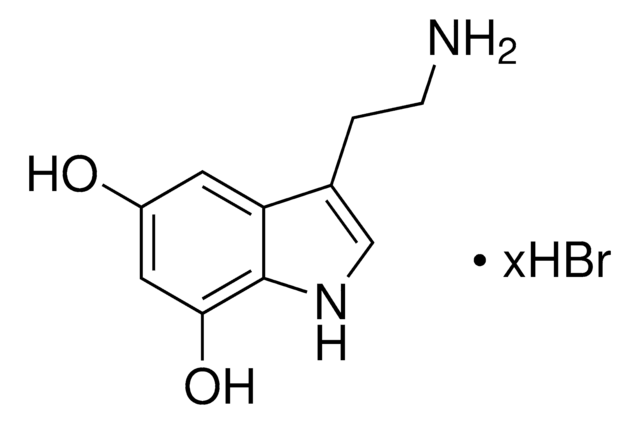H4381
6-Hydroxydopamine hydrochloride
≥97% (titration), powder, neurotoxin
Synonyme(s) :
2,4,5-Trihydroxyphenethylamine hydrochloride, 2,5-Dihydroxytyramine hydrochloride, 2-(2,4,5-Trihydroxyphenyl)ethylamine hydrochloride, 6-OHDA
About This Item
Produits recommandés
product name
6-Hydroxydopamine hydrochloride, ≥97% (titration), powder
Pureté
≥97% (titration)
Forme
powder
Couleur
off-white to brown
Pf
232-233 °C (dec.) (lit.)
Solubilité
H2O: >50 mg/mL, clear, yellow to brown
Température de stockage
room temp
Chaîne SMILES
Cl.NCCc1cc(O)c(O)cc1O
InChI
1S/C8H11NO3.ClH/c9-2-1-5-3-7(11)8(12)4-6(5)10;/h3-4,10-12H,1-2,9H2;1H
Clé InChI
QLMRJHFAGVFUAC-UHFFFAOYSA-N
Vous recherchez des produits similaires ? Visite Guide de comparaison des produits
Description générale
Application
- to induce Parkinson′s disease (PD) in rats
- to analyse cytotoxic effect of 6-OHDA on PC12 cell line
- to induce noradrenergic (NA) neuron deletion from the locus-coeruleus
Actions biochimiques/physiologiques
Attention
Reconstitution
Mention d'avertissement
Warning
Mentions de danger
Conseils de prudence
Classification des risques
Eye Irrit. 2 - Skin Irrit. 2 - STOT SE 3
Organes cibles
Respiratory system
Code de la classe de stockage
11 - Combustible Solids
Classe de danger pour l'eau (WGK)
WGK 3
Équipement de protection individuelle
dust mask type N95 (US), Eyeshields, Gloves
Certificats d'analyse (COA)
Recherchez un Certificats d'analyse (COA) en saisissant le numéro de lot du produit. Les numéros de lot figurent sur l'étiquette du produit après les mots "Lot" ou "Batch".
Déjà en possession de ce produit ?
Retrouvez la documentation relative aux produits que vous avez récemment achetés dans la Bibliothèque de documents.
Les clients ont également consulté
Notre équipe de scientifiques dispose d'une expérience dans tous les secteurs de la recherche, notamment en sciences de la vie, science des matériaux, synthèse chimique, chromatographie, analyse et dans de nombreux autres domaines..
Contacter notre Service technique










